Diploma of Leadership: Emotional Intelligence Assessment - Task 2
VerifiedAdded on 2023/01/06
|24
|6904
|28
Homework Assignment
AI Summary
This assessment, designed for a Diploma of Leadership and Management course, focuses on the application of emotional intelligence in a professional context. The assignment tasks include researching and comparing emotional intelligence assessment tools, applying one tool for self-reflection to identify personal strengths and weaknesses, and analyzing workplace stressors and emotional responses. Additionally, the assessment requires the candidate to describe strategies for managing these stressors and to identify triggers of positive and negative emotional states, emphasizing the importance of feedback and self-awareness in achieving positive outcomes. The student also gathers feedback from colleagues using an emotional intelligence feedback form and develops strategies for improvement. Finally, the assessment requires the student to outline behaviors that demonstrate good management of emotions in the workplace, showcasing a comprehensive understanding of emotional intelligence and its practical application in leadership and management roles.
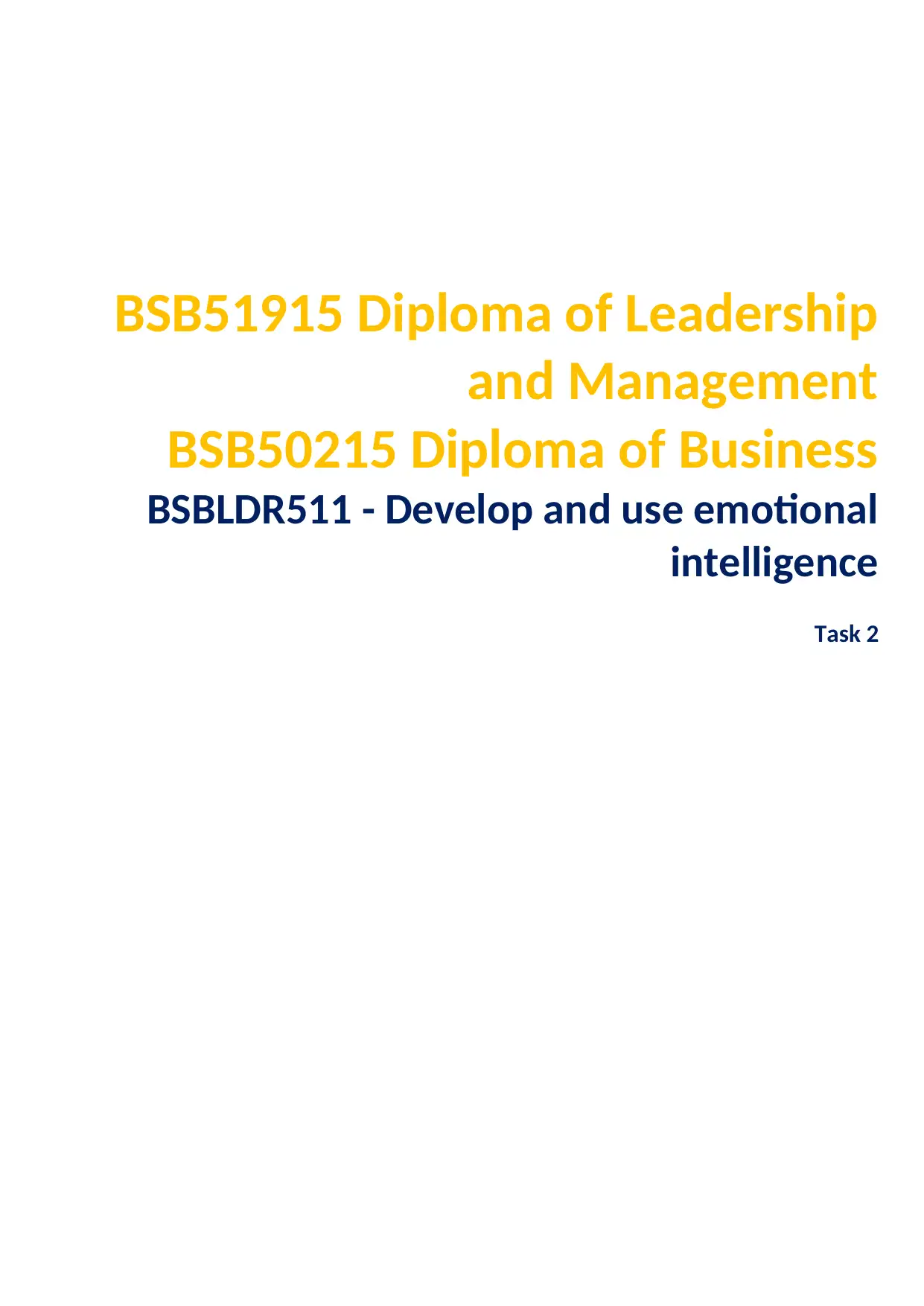
BSB51915 Diploma of Leadership
and Management
BSB50215 Diploma of Business
BSBLDR511 - Develop and use emotional
intelligence
Task 2
and Management
BSB50215 Diploma of Business
BSBLDR511 - Develop and use emotional
intelligence
Task 2
Paraphrase This Document
Need a fresh take? Get an instant paraphrase of this document with our AI Paraphraser
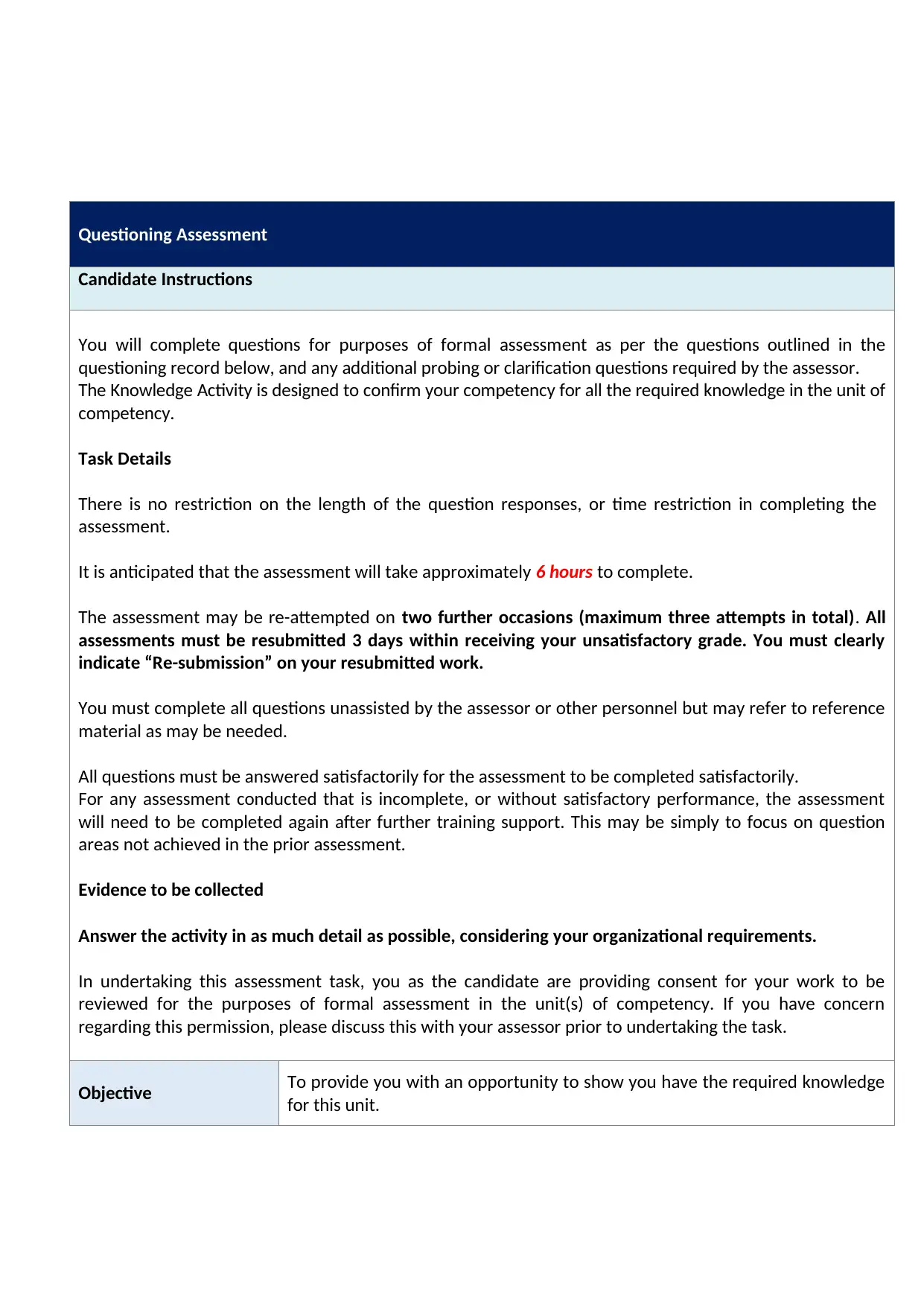
Questioning Assessment
Candidate Instructions
You will complete questions for purposes of formal assessment as per the questions outlined in the
questioning record below, and any additional probing or clarification questions required by the assessor.
The Knowledge Activity is designed to confirm your competency for all the required knowledge in the unit of
competency.
Task Details
There is no restriction on the length of the question responses, or time restriction in completing the
assessment.
It is anticipated that the assessment will take approximately 6 hours to complete.
The assessment may be re-attempted on two further occasions (maximum three attempts in total). All
assessments must be resubmitted 3 days within receiving your unsatisfactory grade. You must clearly
indicate “Re-submission” on your resubmitted work.
You must complete all questions unassisted by the assessor or other personnel but may refer to reference
material as may be needed.
All questions must be answered satisfactorily for the assessment to be completed satisfactorily.
For any assessment conducted that is incomplete, or without satisfactory performance, the assessment
will need to be completed again after further training support. This may be simply to focus on question
areas not achieved in the prior assessment.
Evidence to be collected
Answer the activity in as much detail as possible, considering your organizational requirements.
In undertaking this assessment task, you as the candidate are providing consent for your work to be
reviewed for the purposes of formal assessment in the unit(s) of competency. If you have concern
regarding this permission, please discuss this with your assessor prior to undertaking the task.
Objective To provide you with an opportunity to show you have the required knowledge
for this unit.
Candidate Instructions
You will complete questions for purposes of formal assessment as per the questions outlined in the
questioning record below, and any additional probing or clarification questions required by the assessor.
The Knowledge Activity is designed to confirm your competency for all the required knowledge in the unit of
competency.
Task Details
There is no restriction on the length of the question responses, or time restriction in completing the
assessment.
It is anticipated that the assessment will take approximately 6 hours to complete.
The assessment may be re-attempted on two further occasions (maximum three attempts in total). All
assessments must be resubmitted 3 days within receiving your unsatisfactory grade. You must clearly
indicate “Re-submission” on your resubmitted work.
You must complete all questions unassisted by the assessor or other personnel but may refer to reference
material as may be needed.
All questions must be answered satisfactorily for the assessment to be completed satisfactorily.
For any assessment conducted that is incomplete, or without satisfactory performance, the assessment
will need to be completed again after further training support. This may be simply to focus on question
areas not achieved in the prior assessment.
Evidence to be collected
Answer the activity in as much detail as possible, considering your organizational requirements.
In undertaking this assessment task, you as the candidate are providing consent for your work to be
reviewed for the purposes of formal assessment in the unit(s) of competency. If you have concern
regarding this permission, please discuss this with your assessor prior to undertaking the task.
Objective To provide you with an opportunity to show you have the required knowledge
for this unit.
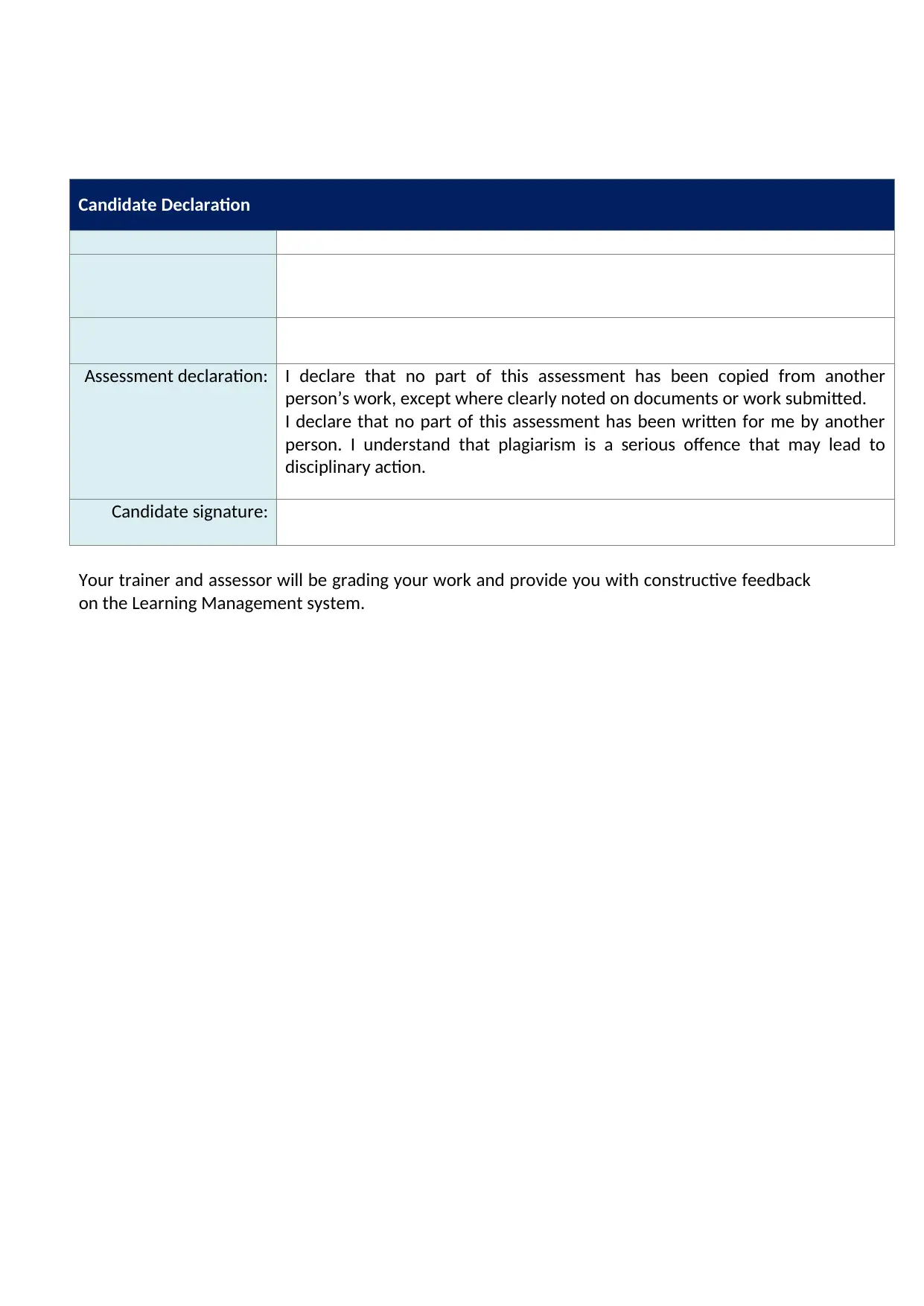
Candidate Declaration
Assessment declaration: I declare that no part of this assessment has been copied from another
person’s work, except where clearly noted on documents or work submitted.
I declare that no part of this assessment has been written for me by another
person. I understand that plagiarism is a serious offence that may lead to
disciplinary action.
Candidate signature:
Your trainer and assessor will be grading your work and provide you with constructive feedback
on the Learning Management system.
Assessment declaration: I declare that no part of this assessment has been copied from another
person’s work, except where clearly noted on documents or work submitted.
I declare that no part of this assessment has been written for me by another
person. I understand that plagiarism is a serious offence that may lead to
disciplinary action.
Candidate signature:
Your trainer and assessor will be grading your work and provide you with constructive feedback
on the Learning Management system.
⊘ This is a preview!⊘
Do you want full access?
Subscribe today to unlock all pages.

Trusted by 1+ million students worldwide
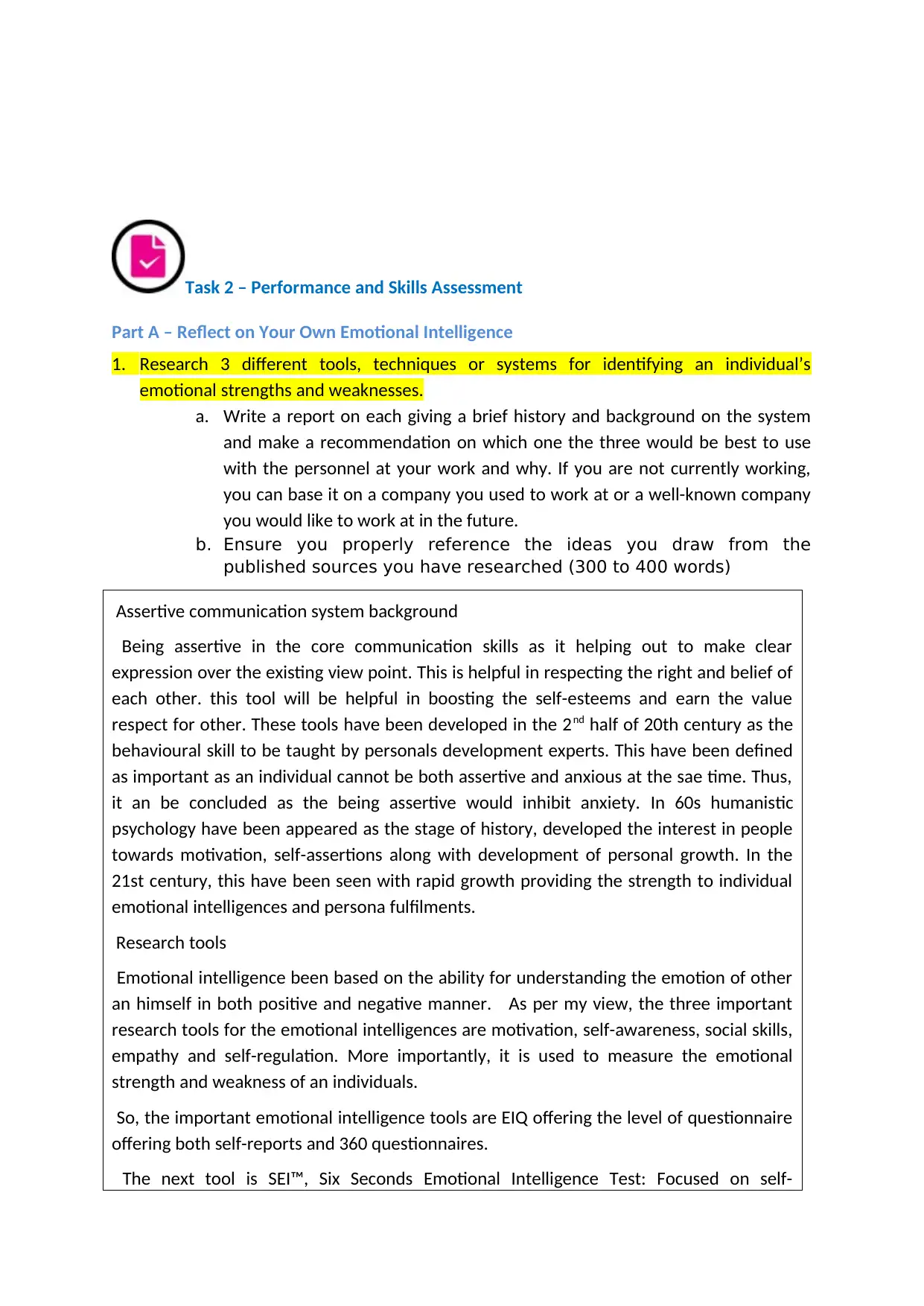
Task 2 – Performance and Skills Assessment
Part A – Reflect on Your Own Emotional Intelligence
1. Research 3 different tools, techniques or systems for identifying an individual’s
emotional strengths and weaknesses.
a. Write a report on each giving a brief history and background on the system
and make a recommendation on which one the three would be best to use
with the personnel at your work and why. If you are not currently working,
you can base it on a company you used to work at or a well-known company
you would like to work at in the future.
b. Ensure you properly reference the ideas you draw from the
published sources you have researched (300 to 400 words)
Assertive communication system background
Being assertive in the core communication skills as it helping out to make clear
expression over the existing view point. This is helpful in respecting the right and belief of
each other. this tool will be helpful in boosting the self-esteems and earn the value
respect for other. These tools have been developed in the 2nd half of 20th century as the
behavioural skill to be taught by personals development experts. This have been defined
as important as an individual cannot be both assertive and anxious at the sae time. Thus,
it an be concluded as the being assertive would inhibit anxiety. In 60s humanistic
psychology have been appeared as the stage of history, developed the interest in people
towards motivation, self-assertions along with development of personal growth. In the
21st century, this have been seen with rapid growth providing the strength to individual
emotional intelligences and persona fulfilments.
Research tools
Emotional intelligence been based on the ability for understanding the emotion of other
an himself in both positive and negative manner. As per my view, the three important
research tools for the emotional intelligences are motivation, self-awareness, social skills,
empathy and self-regulation. More importantly, it is used to measure the emotional
strength and weakness of an individuals.
So, the important emotional intelligence tools are EIQ offering the level of questionnaire
offering both self-reports and 360 questionnaires.
The next tool is SEI™, Six Seconds Emotional Intelligence Test: Focused on self-
Part A – Reflect on Your Own Emotional Intelligence
1. Research 3 different tools, techniques or systems for identifying an individual’s
emotional strengths and weaknesses.
a. Write a report on each giving a brief history and background on the system
and make a recommendation on which one the three would be best to use
with the personnel at your work and why. If you are not currently working,
you can base it on a company you used to work at or a well-known company
you would like to work at in the future.
b. Ensure you properly reference the ideas you draw from the
published sources you have researched (300 to 400 words)
Assertive communication system background
Being assertive in the core communication skills as it helping out to make clear
expression over the existing view point. This is helpful in respecting the right and belief of
each other. this tool will be helpful in boosting the self-esteems and earn the value
respect for other. These tools have been developed in the 2nd half of 20th century as the
behavioural skill to be taught by personals development experts. This have been defined
as important as an individual cannot be both assertive and anxious at the sae time. Thus,
it an be concluded as the being assertive would inhibit anxiety. In 60s humanistic
psychology have been appeared as the stage of history, developed the interest in people
towards motivation, self-assertions along with development of personal growth. In the
21st century, this have been seen with rapid growth providing the strength to individual
emotional intelligences and persona fulfilments.
Research tools
Emotional intelligence been based on the ability for understanding the emotion of other
an himself in both positive and negative manner. As per my view, the three important
research tools for the emotional intelligences are motivation, self-awareness, social skills,
empathy and self-regulation. More importantly, it is used to measure the emotional
strength and weakness of an individuals.
So, the important emotional intelligence tools are EIQ offering the level of questionnaire
offering both self-reports and 360 questionnaires.
The next tool is SEI™, Six Seconds Emotional Intelligence Test: Focused on self-
Paraphrase This Document
Need a fresh take? Get an instant paraphrase of this document with our AI Paraphraser
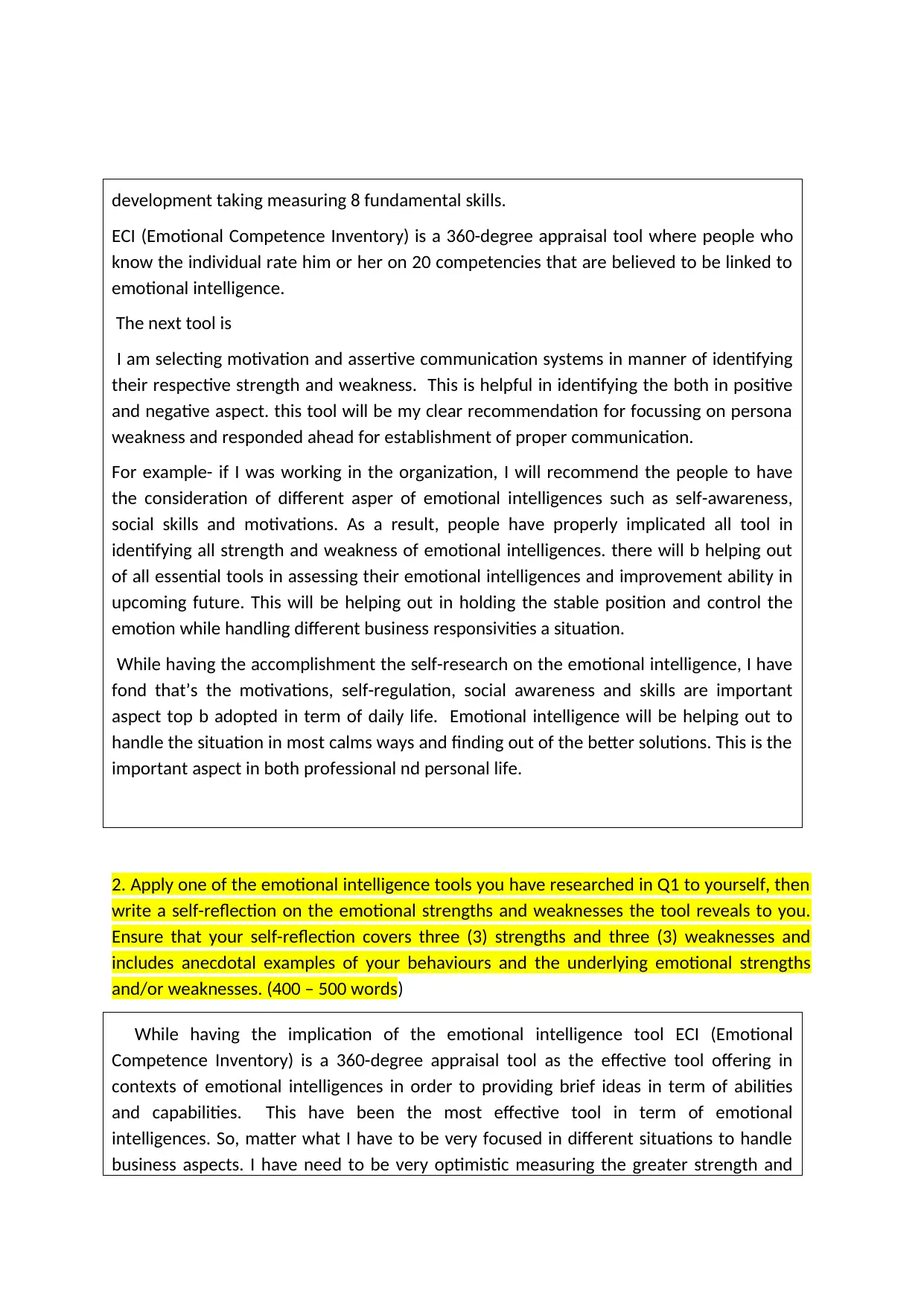
development taking measuring 8 fundamental skills.
ECI (Emotional Competence Inventory) is a 360-degree appraisal tool where people who
know the individual rate him or her on 20 competencies that are believed to be linked to
emotional intelligence.
The next tool is
I am selecting motivation and assertive communication systems in manner of identifying
their respective strength and weakness. This is helpful in identifying the both in positive
and negative aspect. this tool will be my clear recommendation for focussing on persona
weakness and responded ahead for establishment of proper communication.
For example- if I was working in the organization, I will recommend the people to have
the consideration of different asper of emotional intelligences such as self-awareness,
social skills and motivations. As a result, people have properly implicated all tool in
identifying all strength and weakness of emotional intelligences. there will b helping out
of all essential tools in assessing their emotional intelligences and improvement ability in
upcoming future. This will be helping out in holding the stable position and control the
emotion while handling different business responsivities a situation.
While having the accomplishment the self-research on the emotional intelligence, I have
fond that’s the motivations, self-regulation, social awareness and skills are important
aspect top b adopted in term of daily life. Emotional intelligence will be helping out to
handle the situation in most calms ways and finding out of the better solutions. This is the
important aspect in both professional nd personal life.
2. Apply one of the emotional intelligence tools you have researched in Q1 to yourself, then
write a self-reflection on the emotional strengths and weaknesses the tool reveals to you.
Ensure that your self-reflection covers three (3) strengths and three (3) weaknesses and
includes anecdotal examples of your behaviours and the underlying emotional strengths
and/or weaknesses. (400 – 500 words)
While having the implication of the emotional intelligence tool ECI (Emotional
Competence Inventory) is a 360-degree appraisal tool as the effective tool offering in
contexts of emotional intelligences in order to providing brief ideas in term of abilities
and capabilities. This have been the most effective tool in term of emotional
intelligences. So, matter what I have to be very focused in different situations to handle
business aspects. I have need to be very optimistic measuring the greater strength and
ECI (Emotional Competence Inventory) is a 360-degree appraisal tool where people who
know the individual rate him or her on 20 competencies that are believed to be linked to
emotional intelligence.
The next tool is
I am selecting motivation and assertive communication systems in manner of identifying
their respective strength and weakness. This is helpful in identifying the both in positive
and negative aspect. this tool will be my clear recommendation for focussing on persona
weakness and responded ahead for establishment of proper communication.
For example- if I was working in the organization, I will recommend the people to have
the consideration of different asper of emotional intelligences such as self-awareness,
social skills and motivations. As a result, people have properly implicated all tool in
identifying all strength and weakness of emotional intelligences. there will b helping out
of all essential tools in assessing their emotional intelligences and improvement ability in
upcoming future. This will be helping out in holding the stable position and control the
emotion while handling different business responsivities a situation.
While having the accomplishment the self-research on the emotional intelligence, I have
fond that’s the motivations, self-regulation, social awareness and skills are important
aspect top b adopted in term of daily life. Emotional intelligence will be helping out to
handle the situation in most calms ways and finding out of the better solutions. This is the
important aspect in both professional nd personal life.
2. Apply one of the emotional intelligence tools you have researched in Q1 to yourself, then
write a self-reflection on the emotional strengths and weaknesses the tool reveals to you.
Ensure that your self-reflection covers three (3) strengths and three (3) weaknesses and
includes anecdotal examples of your behaviours and the underlying emotional strengths
and/or weaknesses. (400 – 500 words)
While having the implication of the emotional intelligence tool ECI (Emotional
Competence Inventory) is a 360-degree appraisal tool as the effective tool offering in
contexts of emotional intelligences in order to providing brief ideas in term of abilities
and capabilities. This have been the most effective tool in term of emotional
intelligences. So, matter what I have to be very focused in different situations to handle
business aspects. I have need to be very optimistic measuring the greater strength and
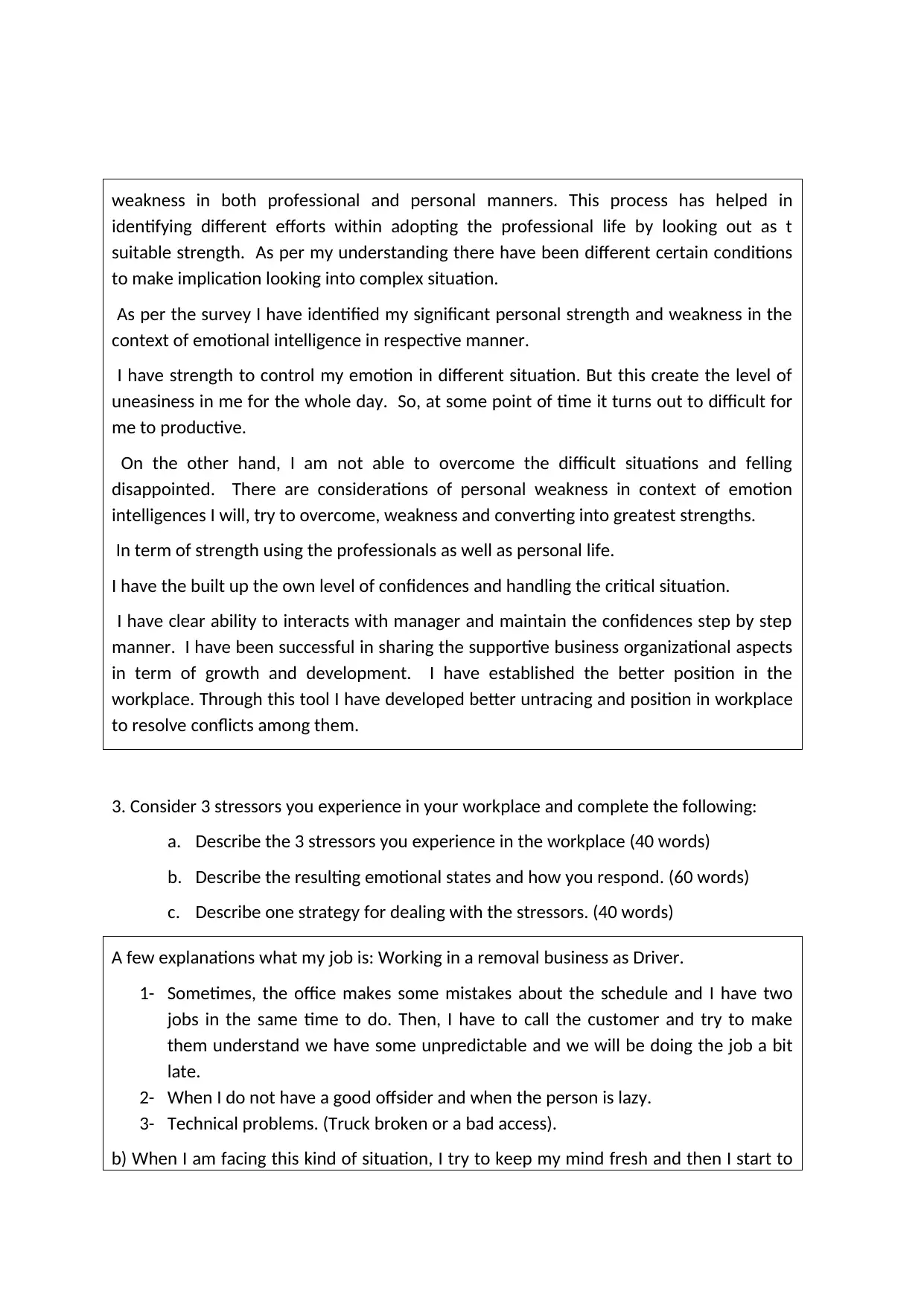
weakness in both professional and personal manners. This process has helped in
identifying different efforts within adopting the professional life by looking out as t
suitable strength. As per my understanding there have been different certain conditions
to make implication looking into complex situation.
As per the survey I have identified my significant personal strength and weakness in the
context of emotional intelligence in respective manner.
I have strength to control my emotion in different situation. But this create the level of
uneasiness in me for the whole day. So, at some point of time it turns out to difficult for
me to productive.
On the other hand, I am not able to overcome the difficult situations and felling
disappointed. There are considerations of personal weakness in context of emotion
intelligences I will, try to overcome, weakness and converting into greatest strengths.
In term of strength using the professionals as well as personal life.
I have the built up the own level of confidences and handling the critical situation.
I have clear ability to interacts with manager and maintain the confidences step by step
manner. I have been successful in sharing the supportive business organizational aspects
in term of growth and development. I have established the better position in the
workplace. Through this tool I have developed better untracing and position in workplace
to resolve conflicts among them.
3. Consider 3 stressors you experience in your workplace and complete the following:
a. Describe the 3 stressors you experience in the workplace (40 words)
b. Describe the resulting emotional states and how you respond. (60 words)
c. Describe one strategy for dealing with the stressors. (40 words)
A few explanations what my job is: Working in a removal business as Driver.
1- Sometimes, the office makes some mistakes about the schedule and I have two
jobs in the same time to do. Then, I have to call the customer and try to make
them understand we have some unpredictable and we will be doing the job a bit
late.
2- When I do not have a good offsider and when the person is lazy.
3- Technical problems. (Truck broken or a bad access).
b) When I am facing this kind of situation, I try to keep my mind fresh and then I start to
identifying different efforts within adopting the professional life by looking out as t
suitable strength. As per my understanding there have been different certain conditions
to make implication looking into complex situation.
As per the survey I have identified my significant personal strength and weakness in the
context of emotional intelligence in respective manner.
I have strength to control my emotion in different situation. But this create the level of
uneasiness in me for the whole day. So, at some point of time it turns out to difficult for
me to productive.
On the other hand, I am not able to overcome the difficult situations and felling
disappointed. There are considerations of personal weakness in context of emotion
intelligences I will, try to overcome, weakness and converting into greatest strengths.
In term of strength using the professionals as well as personal life.
I have the built up the own level of confidences and handling the critical situation.
I have clear ability to interacts with manager and maintain the confidences step by step
manner. I have been successful in sharing the supportive business organizational aspects
in term of growth and development. I have established the better position in the
workplace. Through this tool I have developed better untracing and position in workplace
to resolve conflicts among them.
3. Consider 3 stressors you experience in your workplace and complete the following:
a. Describe the 3 stressors you experience in the workplace (40 words)
b. Describe the resulting emotional states and how you respond. (60 words)
c. Describe one strategy for dealing with the stressors. (40 words)
A few explanations what my job is: Working in a removal business as Driver.
1- Sometimes, the office makes some mistakes about the schedule and I have two
jobs in the same time to do. Then, I have to call the customer and try to make
them understand we have some unpredictable and we will be doing the job a bit
late.
2- When I do not have a good offsider and when the person is lazy.
3- Technical problems. (Truck broken or a bad access).
b) When I am facing this kind of situation, I try to keep my mind fresh and then I start to
⊘ This is a preview!⊘
Do you want full access?
Subscribe today to unlock all pages.

Trusted by 1+ million students worldwide
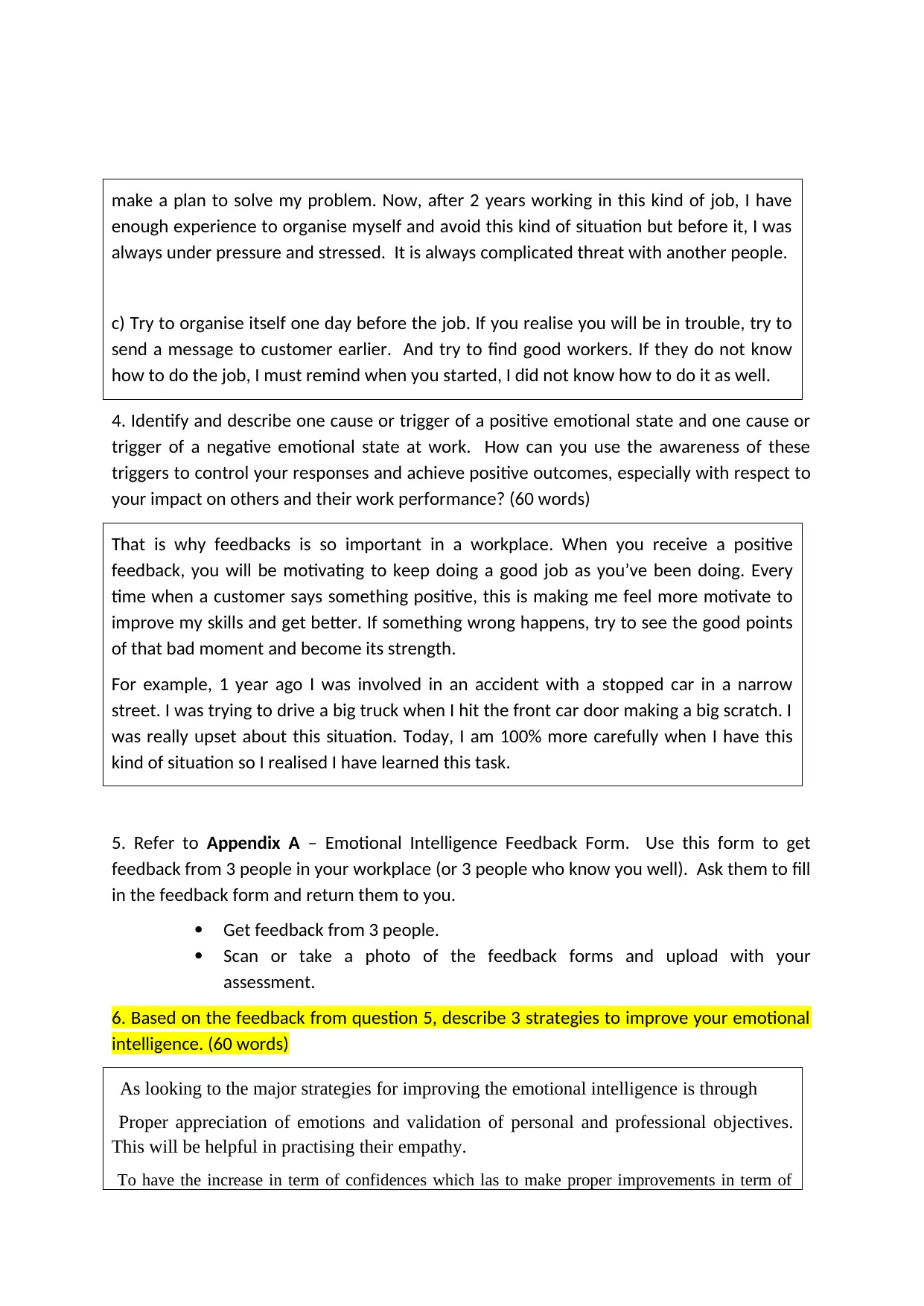
make a plan to solve my problem. Now, after 2 years working in this kind of job, I have
enough experience to organise myself and avoid this kind of situation but before it, I was
always under pressure and stressed. It is always complicated threat with another people.
c) Try to organise itself one day before the job. If you realise you will be in trouble, try to
send a message to customer earlier. And try to find good workers. If they do not know
how to do the job, I must remind when you started, I did not know how to do it as well.
4. Identify and describe one cause or trigger of a positive emotional state and one cause or
trigger of a negative emotional state at work. How can you use the awareness of these
triggers to control your responses and achieve positive outcomes, especially with respect to
your impact on others and their work performance? (60 words)
That is why feedbacks is so important in a workplace. When you receive a positive
feedback, you will be motivating to keep doing a good job as you’ve been doing. Every
time when a customer says something positive, this is making me feel more motivate to
improve my skills and get better. If something wrong happens, try to see the good points
of that bad moment and become its strength.
For example, 1 year ago I was involved in an accident with a stopped car in a narrow
street. I was trying to drive a big truck when I hit the front car door making a big scratch. I
was really upset about this situation. Today, I am 100% more carefully when I have this
kind of situation so I realised I have learned this task.
5. Refer to Appendix A – Emotional Intelligence Feedback Form. Use this form to get
feedback from 3 people in your workplace (or 3 people who know you well). Ask them to fill
in the feedback form and return them to you.
Get feedback from 3 people.
Scan or take a photo of the feedback forms and upload with your
assessment.
6. Based on the feedback from question 5, describe 3 strategies to improve your emotional
intelligence. (60 words)
As looking to the major strategies for improving the emotional intelligence is through
Proper appreciation of emotions and validation of personal and professional objectives.
This will be helpful in practising their empathy.
To have the increase in term of confidences which las to make proper improvements in term of
enough experience to organise myself and avoid this kind of situation but before it, I was
always under pressure and stressed. It is always complicated threat with another people.
c) Try to organise itself one day before the job. If you realise you will be in trouble, try to
send a message to customer earlier. And try to find good workers. If they do not know
how to do the job, I must remind when you started, I did not know how to do it as well.
4. Identify and describe one cause or trigger of a positive emotional state and one cause or
trigger of a negative emotional state at work. How can you use the awareness of these
triggers to control your responses and achieve positive outcomes, especially with respect to
your impact on others and their work performance? (60 words)
That is why feedbacks is so important in a workplace. When you receive a positive
feedback, you will be motivating to keep doing a good job as you’ve been doing. Every
time when a customer says something positive, this is making me feel more motivate to
improve my skills and get better. If something wrong happens, try to see the good points
of that bad moment and become its strength.
For example, 1 year ago I was involved in an accident with a stopped car in a narrow
street. I was trying to drive a big truck when I hit the front car door making a big scratch. I
was really upset about this situation. Today, I am 100% more carefully when I have this
kind of situation so I realised I have learned this task.
5. Refer to Appendix A – Emotional Intelligence Feedback Form. Use this form to get
feedback from 3 people in your workplace (or 3 people who know you well). Ask them to fill
in the feedback form and return them to you.
Get feedback from 3 people.
Scan or take a photo of the feedback forms and upload with your
assessment.
6. Based on the feedback from question 5, describe 3 strategies to improve your emotional
intelligence. (60 words)
As looking to the major strategies for improving the emotional intelligence is through
Proper appreciation of emotions and validation of personal and professional objectives.
This will be helpful in practising their empathy.
To have the increase in term of confidences which las to make proper improvements in term of
Paraphrase This Document
Need a fresh take? Get an instant paraphrase of this document with our AI Paraphraser

emotional along and navigating the uncertain situation with proper strategies.
There is need to make proper self-awareness by making proper recognition in term of emotional
intelligences a significant impact on different human behaviours.
7. Describe 3 behaviours that you can model in your workplace to demonstrate good
management of emotions. (60 words)
1- Learn how to handle negative emotions
There are good and bad moments in a workplace. Learn how to manager bad moments is
essential. If you figure out how to see good points when you get failure or deception, you
will be able to manage it easily. Resilience development is a good strategy too.
2- Increase self-confidence:
You must believe yourself no matter what is going on.
3- Empathy development:
It’s really important understand your feelings. You must know how to control yourself and
emotions. But, understand that another people can have some problems its
indispensable.
Part B – Respond to Emotional Intelligence of Others (Case Study)
For this assessment task, you will read and respond to a case study by answering a set of
written questions.
Introduction to Case Study – Australian Hardware
Australian Hardware (a simulated business) is a large and expanding hardware and
homewares retailer with approximately 140 stores located across Australia. In its vision
statement, Australian Hardware states that it intends to ‘lead the hardware and home-
improvement market in Australia within five years’.
In order to realise this vision, the organisation intends to:
build market share by focusing on the customer experience
control direct and indirect costs through efficient internal processes
There is need to make proper self-awareness by making proper recognition in term of emotional
intelligences a significant impact on different human behaviours.
7. Describe 3 behaviours that you can model in your workplace to demonstrate good
management of emotions. (60 words)
1- Learn how to handle negative emotions
There are good and bad moments in a workplace. Learn how to manager bad moments is
essential. If you figure out how to see good points when you get failure or deception, you
will be able to manage it easily. Resilience development is a good strategy too.
2- Increase self-confidence:
You must believe yourself no matter what is going on.
3- Empathy development:
It’s really important understand your feelings. You must know how to control yourself and
emotions. But, understand that another people can have some problems its
indispensable.
Part B – Respond to Emotional Intelligence of Others (Case Study)
For this assessment task, you will read and respond to a case study by answering a set of
written questions.
Introduction to Case Study – Australian Hardware
Australian Hardware (a simulated business) is a large and expanding hardware and
homewares retailer with approximately 140 stores located across Australia. In its vision
statement, Australian Hardware states that it intends to ‘lead the hardware and home-
improvement market in Australia within five years’.
In order to realise this vision, the organisation intends to:
build market share by focusing on the customer experience
control direct and indirect costs through efficient internal processes
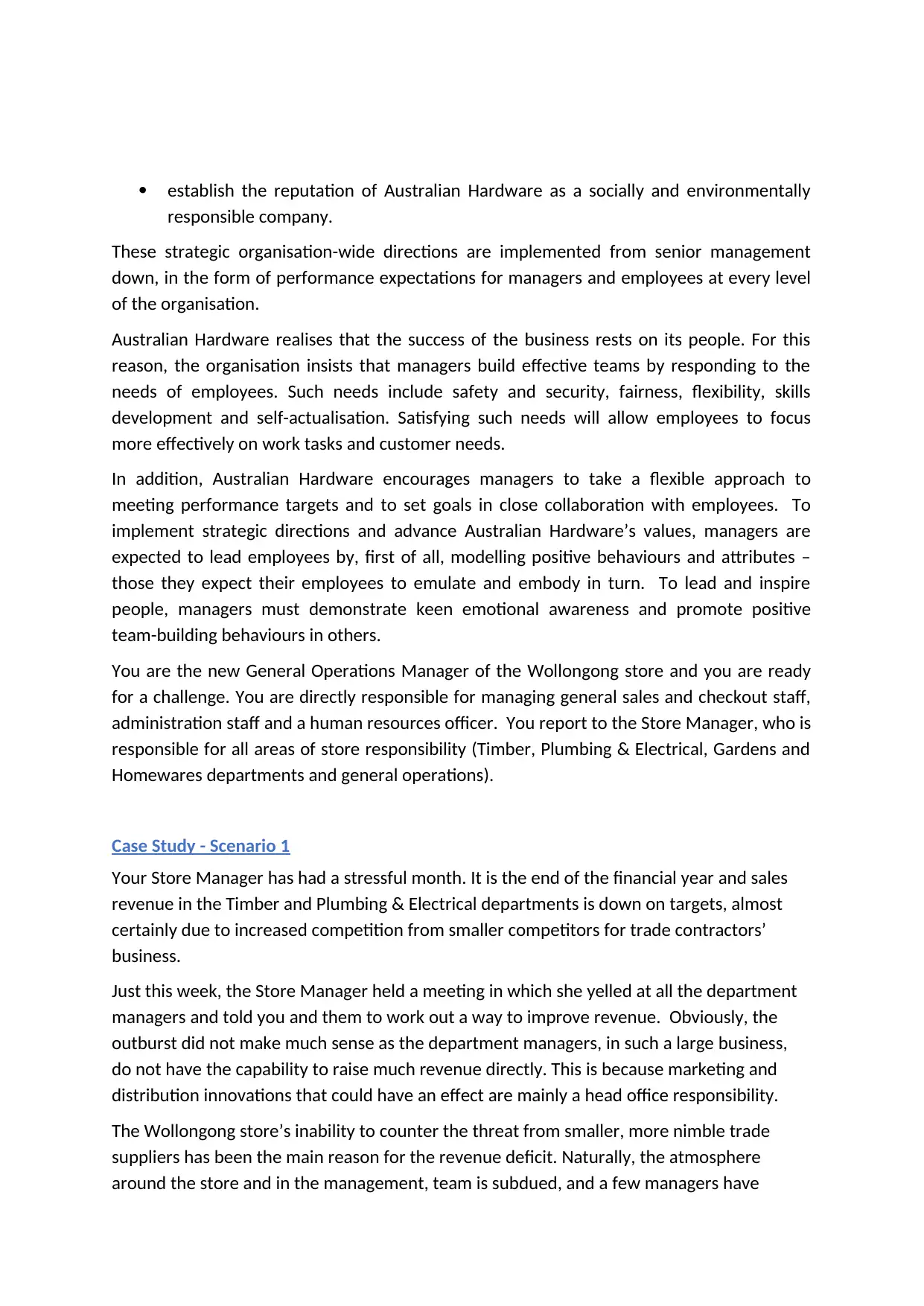
establish the reputation of Australian Hardware as a socially and environmentally
responsible company.
These strategic organisation-wide directions are implemented from senior management
down, in the form of performance expectations for managers and employees at every level
of the organisation.
Australian Hardware realises that the success of the business rests on its people. For this
reason, the organisation insists that managers build effective teams by responding to the
needs of employees. Such needs include safety and security, fairness, flexibility, skills
development and self-actualisation. Satisfying such needs will allow employees to focus
more effectively on work tasks and customer needs.
In addition, Australian Hardware encourages managers to take a flexible approach to
meeting performance targets and to set goals in close collaboration with employees. To
implement strategic directions and advance Australian Hardware’s values, managers are
expected to lead employees by, first of all, modelling positive behaviours and attributes –
those they expect their employees to emulate and embody in turn. To lead and inspire
people, managers must demonstrate keen emotional awareness and promote positive
team-building behaviours in others.
You are the new General Operations Manager of the Wollongong store and you are ready
for a challenge. You are directly responsible for managing general sales and checkout staff,
administration staff and a human resources officer. You report to the Store Manager, who is
responsible for all areas of store responsibility (Timber, Plumbing & Electrical, Gardens and
Homewares departments and general operations).
Case Study - Scenario 1
Your Store Manager has had a stressful month. It is the end of the financial year and sales
revenue in the Timber and Plumbing & Electrical departments is down on targets, almost
certainly due to increased competition from smaller competitors for trade contractors’
business.
Just this week, the Store Manager held a meeting in which she yelled at all the department
managers and told you and them to work out a way to improve revenue. Obviously, the
outburst did not make much sense as the department managers, in such a large business,
do not have the capability to raise much revenue directly. This is because marketing and
distribution innovations that could have an effect are mainly a head office responsibility.
The Wollongong store’s inability to counter the threat from smaller, more nimble trade
suppliers has been the main reason for the revenue deficit. Naturally, the atmosphere
around the store and in the management, team is subdued, and a few managers have
responsible company.
These strategic organisation-wide directions are implemented from senior management
down, in the form of performance expectations for managers and employees at every level
of the organisation.
Australian Hardware realises that the success of the business rests on its people. For this
reason, the organisation insists that managers build effective teams by responding to the
needs of employees. Such needs include safety and security, fairness, flexibility, skills
development and self-actualisation. Satisfying such needs will allow employees to focus
more effectively on work tasks and customer needs.
In addition, Australian Hardware encourages managers to take a flexible approach to
meeting performance targets and to set goals in close collaboration with employees. To
implement strategic directions and advance Australian Hardware’s values, managers are
expected to lead employees by, first of all, modelling positive behaviours and attributes –
those they expect their employees to emulate and embody in turn. To lead and inspire
people, managers must demonstrate keen emotional awareness and promote positive
team-building behaviours in others.
You are the new General Operations Manager of the Wollongong store and you are ready
for a challenge. You are directly responsible for managing general sales and checkout staff,
administration staff and a human resources officer. You report to the Store Manager, who is
responsible for all areas of store responsibility (Timber, Plumbing & Electrical, Gardens and
Homewares departments and general operations).
Case Study - Scenario 1
Your Store Manager has had a stressful month. It is the end of the financial year and sales
revenue in the Timber and Plumbing & Electrical departments is down on targets, almost
certainly due to increased competition from smaller competitors for trade contractors’
business.
Just this week, the Store Manager held a meeting in which she yelled at all the department
managers and told you and them to work out a way to improve revenue. Obviously, the
outburst did not make much sense as the department managers, in such a large business,
do not have the capability to raise much revenue directly. This is because marketing and
distribution innovations that could have an effect are mainly a head office responsibility.
The Wollongong store’s inability to counter the threat from smaller, more nimble trade
suppliers has been the main reason for the revenue deficit. Naturally, the atmosphere
around the store and in the management, team is subdued, and a few managers have
⊘ This is a preview!⊘
Do you want full access?
Subscribe today to unlock all pages.

Trusted by 1+ million students worldwide
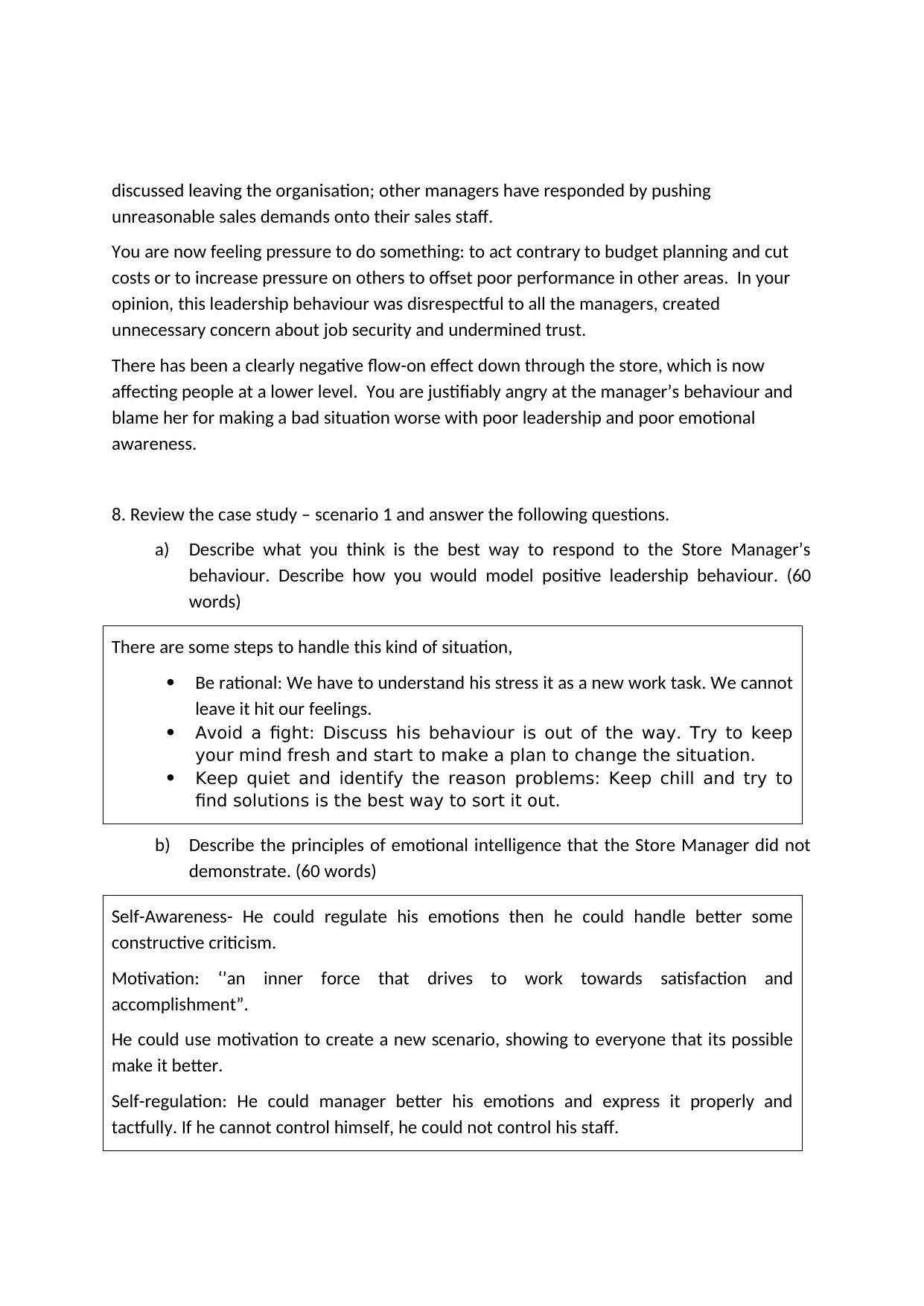
discussed leaving the organisation; other managers have responded by pushing
unreasonable sales demands onto their sales staff.
You are now feeling pressure to do something: to act contrary to budget planning and cut
costs or to increase pressure on others to offset poor performance in other areas. In your
opinion, this leadership behaviour was disrespectful to all the managers, created
unnecessary concern about job security and undermined trust.
There has been a clearly negative flow-on effect down through the store, which is now
affecting people at a lower level. You are justifiably angry at the manager’s behaviour and
blame her for making a bad situation worse with poor leadership and poor emotional
awareness.
8. Review the case study – scenario 1 and answer the following questions.
a) Describe what you think is the best way to respond to the Store Manager’s
behaviour. Describe how you would model positive leadership behaviour. (60
words)
There are some steps to handle this kind of situation,
Be rational: We have to understand his stress it as a new work task. We cannot
leave it hit our feelings.
Avoid a fight: Discuss his behaviour is out of the way. Try to keep
your mind fresh and start to make a plan to change the situation.
Keep quiet and identify the reason problems: Keep chill and try to
find solutions is the best way to sort it out.
b) Describe the principles of emotional intelligence that the Store Manager did not
demonstrate. (60 words)
Self-Awareness- He could regulate his emotions then he could handle better some
constructive criticism.
Motivation: ‘’an inner force that drives to work towards satisfaction and
accomplishment”.
He could use motivation to create a new scenario, showing to everyone that its possible
make it better.
Self-regulation: He could manager better his emotions and express it properly and
tactfully. If he cannot control himself, he could not control his staff.
unreasonable sales demands onto their sales staff.
You are now feeling pressure to do something: to act contrary to budget planning and cut
costs or to increase pressure on others to offset poor performance in other areas. In your
opinion, this leadership behaviour was disrespectful to all the managers, created
unnecessary concern about job security and undermined trust.
There has been a clearly negative flow-on effect down through the store, which is now
affecting people at a lower level. You are justifiably angry at the manager’s behaviour and
blame her for making a bad situation worse with poor leadership and poor emotional
awareness.
8. Review the case study – scenario 1 and answer the following questions.
a) Describe what you think is the best way to respond to the Store Manager’s
behaviour. Describe how you would model positive leadership behaviour. (60
words)
There are some steps to handle this kind of situation,
Be rational: We have to understand his stress it as a new work task. We cannot
leave it hit our feelings.
Avoid a fight: Discuss his behaviour is out of the way. Try to keep
your mind fresh and start to make a plan to change the situation.
Keep quiet and identify the reason problems: Keep chill and try to
find solutions is the best way to sort it out.
b) Describe the principles of emotional intelligence that the Store Manager did not
demonstrate. (60 words)
Self-Awareness- He could regulate his emotions then he could handle better some
constructive criticism.
Motivation: ‘’an inner force that drives to work towards satisfaction and
accomplishment”.
He could use motivation to create a new scenario, showing to everyone that its possible
make it better.
Self-regulation: He could manager better his emotions and express it properly and
tactfully. If he cannot control himself, he could not control his staff.
Paraphrase This Document
Need a fresh take? Get an instant paraphrase of this document with our AI Paraphraser
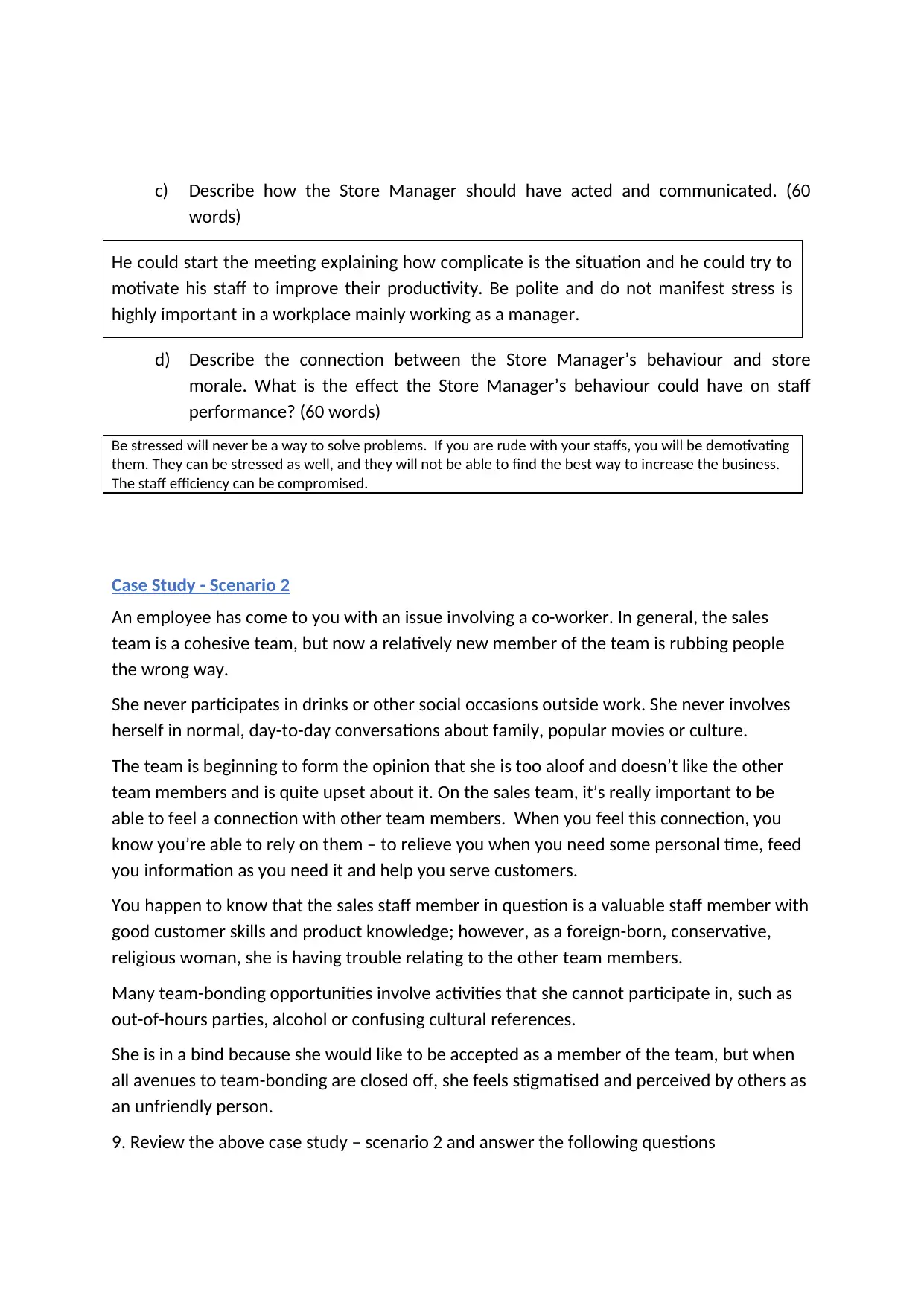
c) Describe how the Store Manager should have acted and communicated. (60
words)
He could start the meeting explaining how complicate is the situation and he could try to
motivate his staff to improve their productivity. Be polite and do not manifest stress is
highly important in a workplace mainly working as a manager.
d) Describe the connection between the Store Manager’s behaviour and store
morale. What is the effect the Store Manager’s behaviour could have on staff
performance? (60 words)
Be stressed will never be a way to solve problems. If you are rude with your staffs, you will be demotivating
them. They can be stressed as well, and they will not be able to find the best way to increase the business.
The staff efficiency can be compromised.
Case Study - Scenario 2
An employee has come to you with an issue involving a co-worker. In general, the sales
team is a cohesive team, but now a relatively new member of the team is rubbing people
the wrong way.
She never participates in drinks or other social occasions outside work. She never involves
herself in normal, day-to-day conversations about family, popular movies or culture.
The team is beginning to form the opinion that she is too aloof and doesn’t like the other
team members and is quite upset about it. On the sales team, it’s really important to be
able to feel a connection with other team members. When you feel this connection, you
know you’re able to rely on them – to relieve you when you need some personal time, feed
you information as you need it and help you serve customers.
You happen to know that the sales staff member in question is a valuable staff member with
good customer skills and product knowledge; however, as a foreign-born, conservative,
religious woman, she is having trouble relating to the other team members.
Many team-bonding opportunities involve activities that she cannot participate in, such as
out-of-hours parties, alcohol or confusing cultural references.
She is in a bind because she would like to be accepted as a member of the team, but when
all avenues to team-bonding are closed off, she feels stigmatised and perceived by others as
an unfriendly person.
9. Review the above case study – scenario 2 and answer the following questions
words)
He could start the meeting explaining how complicate is the situation and he could try to
motivate his staff to improve their productivity. Be polite and do not manifest stress is
highly important in a workplace mainly working as a manager.
d) Describe the connection between the Store Manager’s behaviour and store
morale. What is the effect the Store Manager’s behaviour could have on staff
performance? (60 words)
Be stressed will never be a way to solve problems. If you are rude with your staffs, you will be demotivating
them. They can be stressed as well, and they will not be able to find the best way to increase the business.
The staff efficiency can be compromised.
Case Study - Scenario 2
An employee has come to you with an issue involving a co-worker. In general, the sales
team is a cohesive team, but now a relatively new member of the team is rubbing people
the wrong way.
She never participates in drinks or other social occasions outside work. She never involves
herself in normal, day-to-day conversations about family, popular movies or culture.
The team is beginning to form the opinion that she is too aloof and doesn’t like the other
team members and is quite upset about it. On the sales team, it’s really important to be
able to feel a connection with other team members. When you feel this connection, you
know you’re able to rely on them – to relieve you when you need some personal time, feed
you information as you need it and help you serve customers.
You happen to know that the sales staff member in question is a valuable staff member with
good customer skills and product knowledge; however, as a foreign-born, conservative,
religious woman, she is having trouble relating to the other team members.
Many team-bonding opportunities involve activities that she cannot participate in, such as
out-of-hours parties, alcohol or confusing cultural references.
She is in a bind because she would like to be accepted as a member of the team, but when
all avenues to team-bonding are closed off, she feels stigmatised and perceived by others as
an unfriendly person.
9. Review the above case study – scenario 2 and answer the following questions

a. Provide at least two examples of possible misinterpretations of expressions or
behaviour that may arise in the context of a diverse, multi-cultural workforce.
Length: (60 words)
Avoid some jokes in a workplace. That is true we must keep a good environment in a workplace and a
good way to make it is laughing. But, in a multi-cultural workplace we have to try to avoid some jokes.
People cannot understand exactly what the joke means and make it a big misunderstand.
Avoid talk about religion. Discuss about religion will never be a good decision to do. Everyone believes in
something different and we must respect it.
Dress code. People from different country usually have a typical way to dress out. Cannot be acceptable
people joking about it.
b. Describe how you would explain to the employee who complained about this
worker’s behaviour, how cultural expressions may be misinterpreted – and have
been in this case. (60 words)
Give some examples about previous cases is always a good way. In general, managers at
all have a lot of histories from the past. Give them some previous cases can be an easy
way to show them that is just a different culture and there is nothing wrong with her.
c. Discuss how the team can raise their awareness of cultural expression and
promote effective communication to avoid misunderstandings to resolve the
differences. (60 words)
Keep an open mind.
Have at least some knowledge of people’s cultural backgrounds.
Maintain a personal touch
Practice active listening.
Watch your nonverbal communication.
d. Create a plan of at least 3 actions for identifying and responding appropriately to
a range of cultural expressions of emotions
Action Plan Person Due Date
Bridge the culture gap with good communication skills Team Leaders Keep
practicing
while
working
behaviour that may arise in the context of a diverse, multi-cultural workforce.
Length: (60 words)
Avoid some jokes in a workplace. That is true we must keep a good environment in a workplace and a
good way to make it is laughing. But, in a multi-cultural workplace we have to try to avoid some jokes.
People cannot understand exactly what the joke means and make it a big misunderstand.
Avoid talk about religion. Discuss about religion will never be a good decision to do. Everyone believes in
something different and we must respect it.
Dress code. People from different country usually have a typical way to dress out. Cannot be acceptable
people joking about it.
b. Describe how you would explain to the employee who complained about this
worker’s behaviour, how cultural expressions may be misinterpreted – and have
been in this case. (60 words)
Give some examples about previous cases is always a good way. In general, managers at
all have a lot of histories from the past. Give them some previous cases can be an easy
way to show them that is just a different culture and there is nothing wrong with her.
c. Discuss how the team can raise their awareness of cultural expression and
promote effective communication to avoid misunderstandings to resolve the
differences. (60 words)
Keep an open mind.
Have at least some knowledge of people’s cultural backgrounds.
Maintain a personal touch
Practice active listening.
Watch your nonverbal communication.
d. Create a plan of at least 3 actions for identifying and responding appropriately to
a range of cultural expressions of emotions
Action Plan Person Due Date
Bridge the culture gap with good communication skills Team Leaders Keep
practicing
while
working
⊘ This is a preview!⊘
Do you want full access?
Subscribe today to unlock all pages.

Trusted by 1+ million students worldwide
1 out of 24
Related Documents
Your All-in-One AI-Powered Toolkit for Academic Success.
+13062052269
info@desklib.com
Available 24*7 on WhatsApp / Email
![[object Object]](/_next/static/media/star-bottom.7253800d.svg)
Unlock your academic potential
Copyright © 2020–2025 A2Z Services. All Rights Reserved. Developed and managed by ZUCOL.





